2022 TOYOTA SUPRA tyre pressure
[x] Cancel search: tyre pressurePage 297 of 498
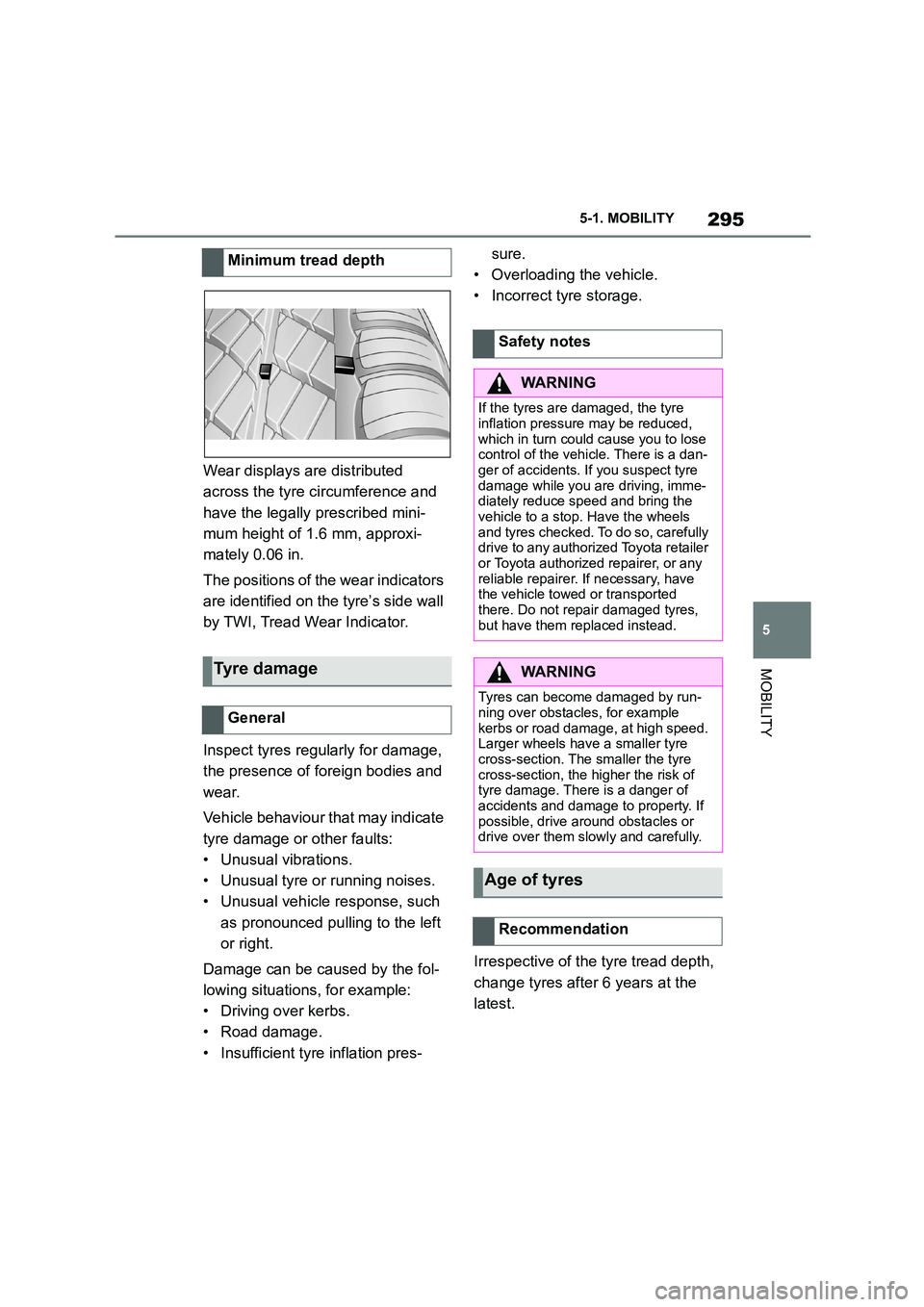
295
5
5-1. MOBILITY
MOBILITY
Wear displays are distributed
across the tyre circumference and
have the legally prescribed mini-
mum height of 1.6 mm, approxi-
mately 0.06 in.
The positions of the wear indicators
are identified on the tyre’s side wall
by TWI, Tread Wear Indicator.
Inspect tyres regularly for damage,
the presence of foreign bodies and
wear.
Vehicle behaviour that may indicate
tyre damage or other faults:
• Unusual vibrations.
• Unusual tyre or running noises.
• Unusual vehicle response, such
as pronounced pu lling to the left
or right.
Damage can be caused by the fol-
lowing situations, for example:
• Driving over kerbs.
• Road damage.
• Insufficient tyre inflation pres-
sure.
• Overloading the vehicle.
• Incorrect tyre storage.
Irrespective of the tyre tread depth,
change tyres after 6 years at the
latest.
Minimum tread depth
Tyre damage
General
Safety notes
WA R N I N G
If the tyres are damaged, the tyre
inflation pressure may be reduced,
which in turn could cause you to lose control of the vehicle. There is a dan-
ger of accidents. If you suspect tyre
damage while you are driving, imme- diately reduce speed and bring the
vehicle to a stop. Have the wheels
and tyres checked. To do so, carefully drive to any authorized Toyota retailer
or Toyota authorized repairer, or any
reliable repairer. If necessary, have the vehicle towed or transported
there. Do not repair damaged tyres,
but have them replaced instead.
WA R N I N G
Tyres can become damaged by run-
ning over obstacles, for example
kerbs or road damage, at high speed. Larger wheels have a smaller tyre
cross-section. The smaller the tyre
cross-section, the higher the risk of tyre damage. There is a danger of
accidents and damage to property. If
possible, drive around obstacles or drive over them slowly and carefully.
Age of tyres
Recommendation
Page 300 of 498
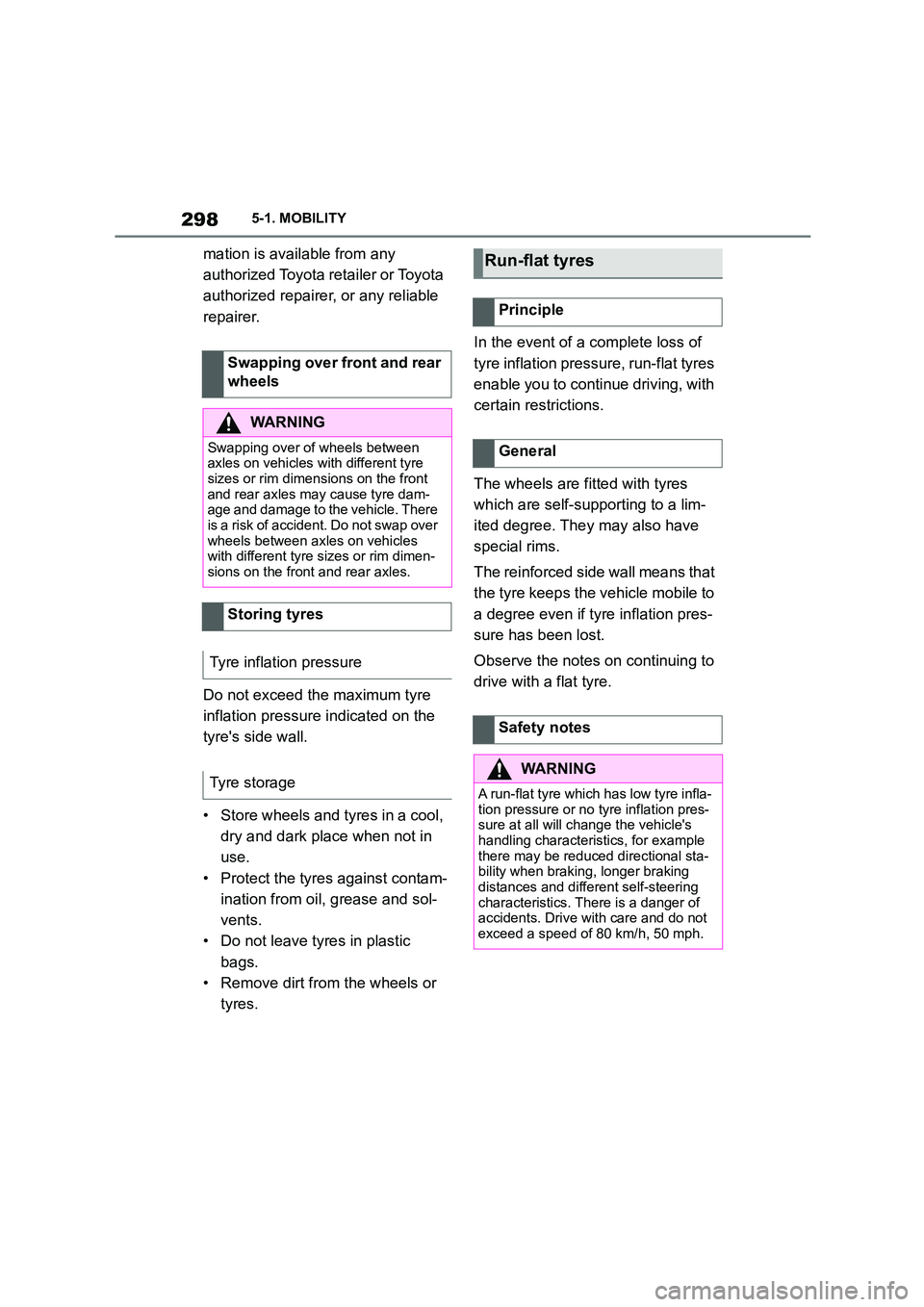
2985-1. MOBILITY
mation is available from any
authorized Toyota retailer or Toyota
authorized repairer, or any reliable
repairer.
Do not exceed the maximum tyre
inflation pressure indicated on the
tyre's side wall.
• Store wheels and tyres in a cool,
dry and dark place when not in
use.
• Protect the tyres against contam-
ination from oil, grease and sol-
vents.
• Do not leave tyres in plastic
bags.
• Remove dirt from the wheels or
tyres.
In the event of a complete loss of
tyre inflation pressure, run-flat tyres
enable you to continue driving, with
certain restrictions.
The wheels are fitted with tyres
which are self-supporting to a lim-
ited degree. They may also have
special rims.
The reinforced side wall means that
the tyre keeps the vehicle mobile to
a degree even if tyre inflation pres-
sure has been lost.
Observe the notes on continuing to
drive with a flat tyre.
Swapping over front and rear
wheels
WA R N I N G
Swapping over of wheels between
axles on vehicles with different tyre
sizes or rim dimensions on the front and rear axles may cause tyre dam-
age and damage to the vehicle. There
is a risk of accident. Do not swap over wheels between axles on vehicles
with different tyre sizes or rim dimen-
sions on the front and rear axles.
Storing tyres
Tyre inflation pressure
Tyre storage
Run-flat tyres
Principle
General
Safety notes
WA R N I N G
A run-flat tyre which has low tyre infla-
tion pressure or no tyre inflation pres- sure at all will change the vehicle's
handling characteristics, for example
there may be reduced directional sta- bility when braking, longer braking
distances and different self-steering
characteristics. There is a danger of accidents. Drive with care and do not
exceed a speed of 80 km/h, 50 mph.
Page 302 of 498
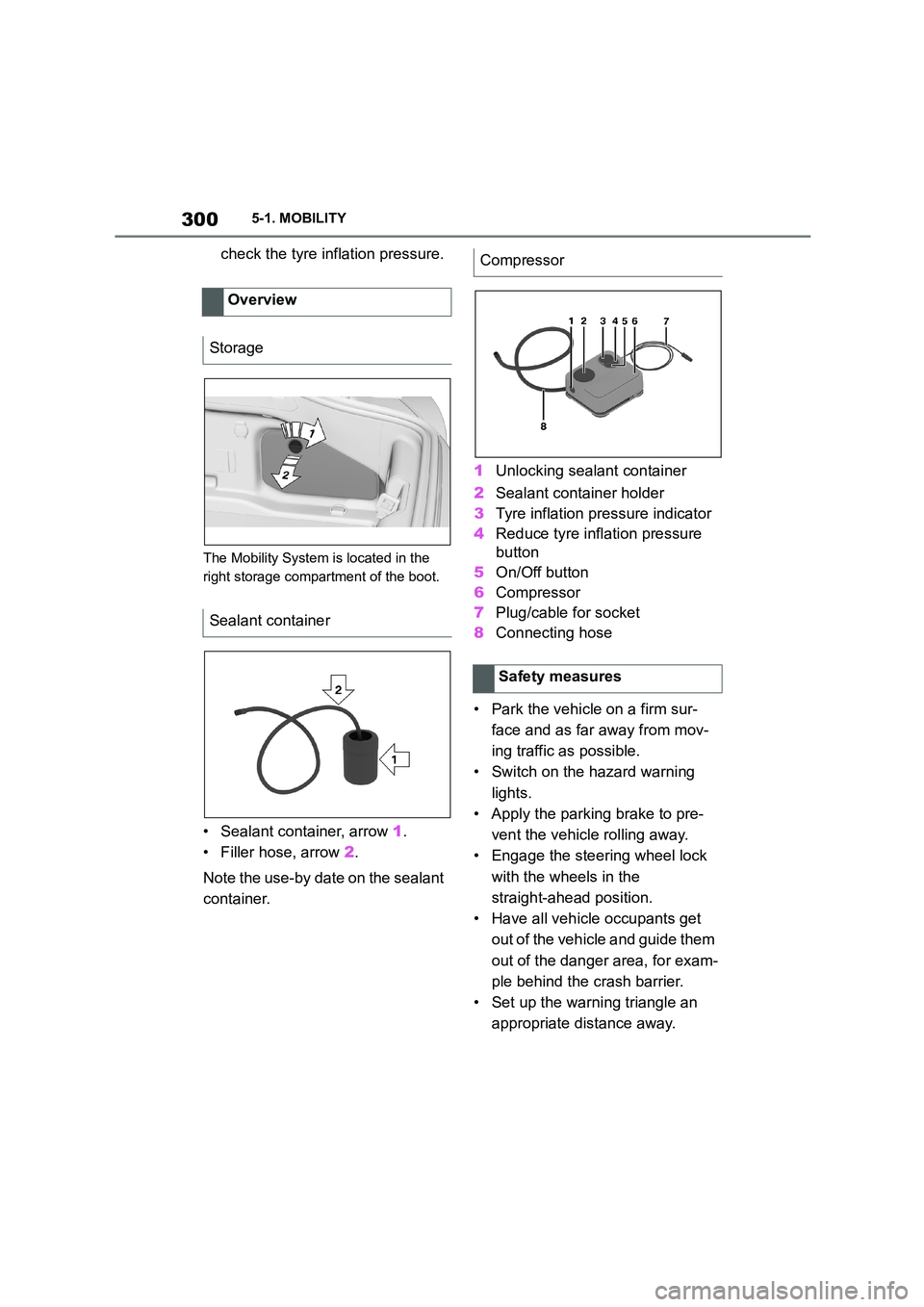
3005-1. MOBILITY
check the tyre inflation pressure.
The Mobility System is located in the
right storage compartment of the boot.
• Sealant container, arrow 1.
• Filler hose, arrow 2.
Note the use-by date on the sealant
container.
1 Unlocking sealant container
2 Sealant container holder
3 Tyre inflation pressure indicator
4 Reduce tyre inflation pressure
button
5 On/Off button
6 Compressor
7 Plug/cable for socket
8 Connecting hose
• Park the vehicle on a firm sur-
face and as far away from mov-
ing traffic as possible.
• Switch on the hazard warning
lights.
• Apply the parking brake to pre-
vent the vehicle rolling away.
• Engage the steering wheel lock
with the wheels in the
straight-ahead position.
• Have all vehicle occupants get
out of the vehicle and guide them
out of the danger area, for exam-
ple behind the crash barrier.
• Set up the warning triangle an
appropriate distance away.
Overview
Storage
Sealant container
Compressor
Safety measures
Page 304 of 498
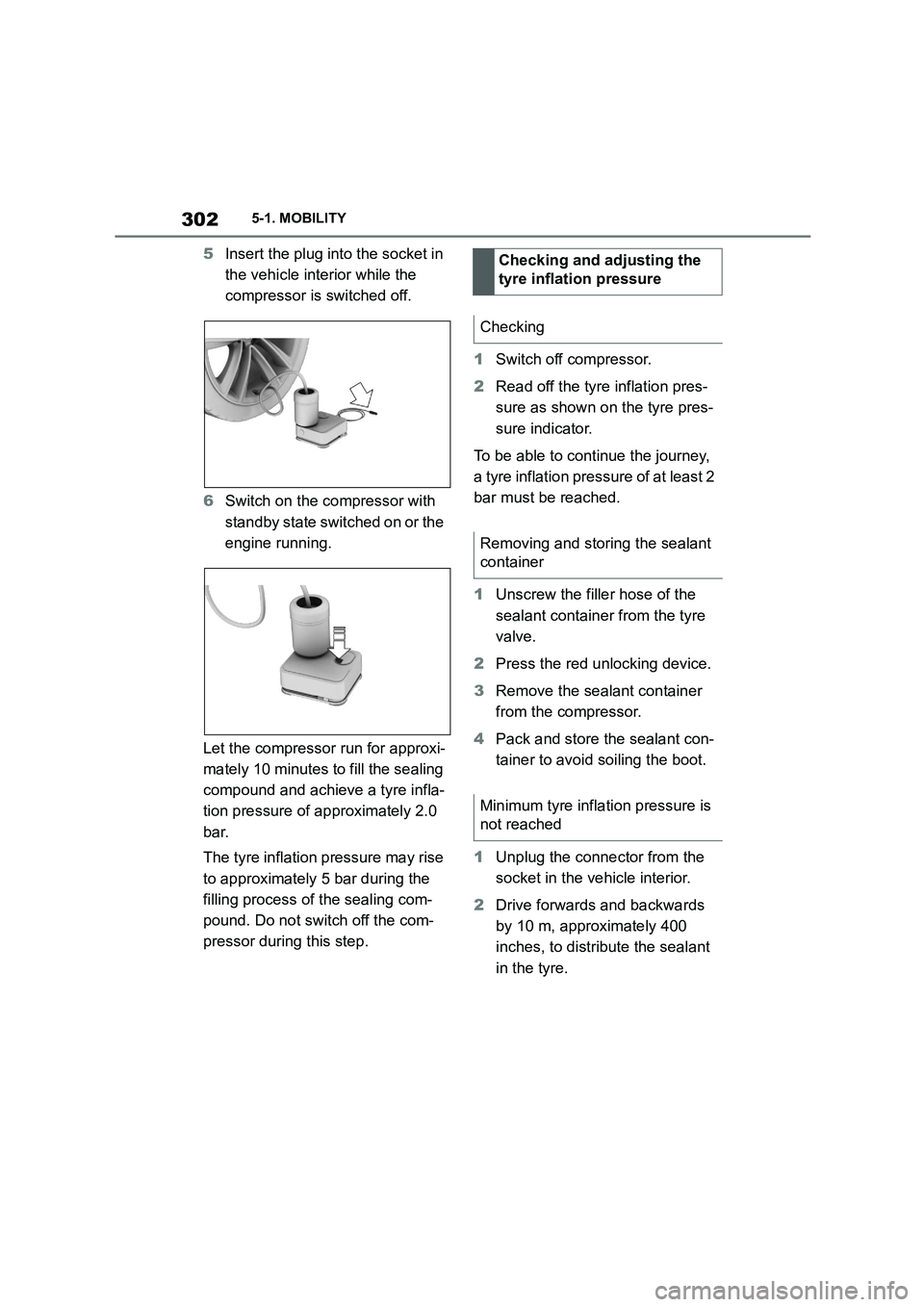
3025-1. MOBILITY
5Insert the plug into the socket in
the vehicle interior while the
compressor is switched off.
6 Switch on the compressor with
standby state switched on or the
engine running.
Let the compressor run for approxi-
mately 10 minutes to fill the sealing
compound and achieve a tyre infla-
tion pressure of approximately 2.0
bar.
The tyre inflation pressure may rise
to approximately 5 bar during the
filling process of the sealing com-
pound. Do not switch off the com-
pressor during this step.
1 Switch off compressor.
2 Read off the tyre inflation pres-
sure as shown on the tyre pres-
sure indicator.
To be able to continue the journey,
a tyre inflation pressure of at least 2
bar must be reached.
1 Unscrew the filler hose of the
sealant container from the tyre
valve.
2 Press the red unlocking device.
3 Remove the sealant container
from the compressor.
4 Pack and store the sealant con-
tainer to avoid soiling the boot.
1 Unplug the connector from the
socket in the vehicle interior.
2 Drive forwards and backwards
by 10 m, approximately 400
inches, to distribute the sealant
in the tyre.
Checking and adjusting the
tyre inflation pressure
Checking
Removing and storing the sealant
container
Minimum tyre inflation pressure is
not reached
Page 305 of 498

303
5
5-1. MOBILITY
MOBILITY
3 Screw the connecting hose of
the compressor directly onto the
tyre valve.
4 Insert the plug into the socket in
the vehicle interior.
5 Switch on the compressor with
standby state switched on or the
engine running.
If the tyre inflation pressure of at least 2
bar is not reached, contact any author-
ized Toyota retailer or Toyota author- ized repairer, or any reliable repairer.
If the tyre inflation pressure of at least 2
bar is reached, see Minimum inflation pressure is reached.
6 Unscrew the connecting hose of
the compressor from the tyre
valve.
7 Unplug the connector from the
socket in the vehicle interior.
8 Store Mobility System in the
vehicle.
1 Unscrew the connecting hose of
the compressor from the tyre
valve.
2 Unplug the connector from the
socket in the vehicle interior.
3 Store Mobility System in the
vehicle.
4 Immediately drive for approxi-
mately 10 km/5 mi to evenly dis-
tribute the sealing compound in
the tyre.
Do not exceed a speed of 80 km/h/50 mph.
If possible, do not drive slower than 20
km/h/12 mph.
1 Stop in a suitable area.
2 Screw the connecting hose of
the compressor directly onto the
tyre valve.
Minimum tyre inflation pressure is
reached
Adjusting
Page 306 of 498

3045-1. MOBILITY
3Insert the plug into the socket in
the vehicle interior.
4 Correct tyre inflation pressure to
at least 2.0 bar.
• To increase tyre inflation pres-
sure: switch on the compressor
with standby state switched on or
the engine running.
• To reduce tyre inflation pressure:
press the button on the compres-
sor.
5 Unscrew the connecting hose of
the compressor from the tyre
valve.
6 Unplug the connector from the
socket in the vehicle interior.
7 Store Mobility System in the
vehicle.
Do not exceed maximum permitted
speed of 80 km/h, approximately 50
mph.
Reset the Tyre Pressure Monitor
(TPM), see page 304.
Have the punctured tyre and the
sealant containe r of the Mobility
System replaced as soon as possi-
ble.
Tire chains cannot be mounted.
Snow tires should be used instead.
The system monitors the tyre infla-
tion pressure in the four fitted tyres.
The system warns if the tyre infla-
tion pressure in one or more tyres
has fallen.
Sensors in the tyre valves measure
the tyre inflation pressure and tyre
temperature.
The system detects the fitted tyres
automatically. The system shows
the preset specified pressures on
the Control Display and compares
them to the current tyre inflation
pressures.
If tyres are fitted which are not
listed on the tyre inflation pressure
labels in the vehicle, see page 292,
Resuming with journey
Snow chains
Selecting tire chains
NOTICE
■Driving with tire chains
Do not fit tire chains. Tire chains may
damage the vehicle body and sus- pension, and adversely affect driving
performance.
Tyre Pressure Monitor (TPM)
Principle
General
Page 307 of 498
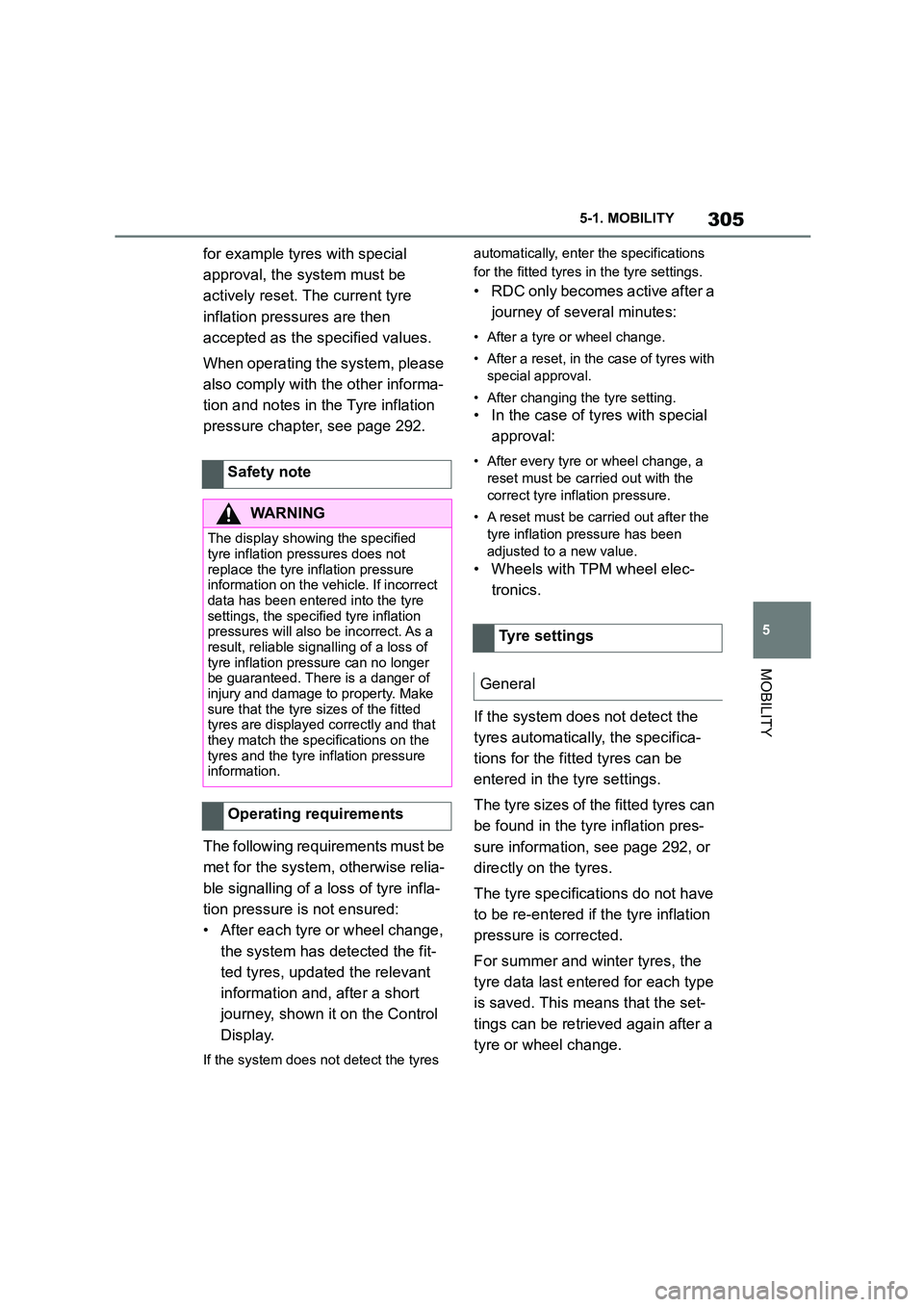
305
5
5-1. MOBILITY
MOBILITY
for example tyres with special
approval, the system must be
actively reset. The current tyre
inflation pressures are then
accepted as the specified values.
When operating the system, please
also comply with the other informa-
tion and notes in the Tyre inflation
pressure chapter, see page 292.
The following requirements must be
met for the system, otherwise relia-
ble signalling of a loss of tyre infla-
tion pressure is not ensured:
• After each tyre or wheel change,
the system has detected the fit-
ted tyres, updated the relevant
information and, after a short
journey, shown it on the Control
Display.
If the system does not detect the tyres
automatically, enter the specifications
for the fitted tyres in the tyre settings.
• RDC only becomes active after a
journey of several minutes:
• After a tyre or wheel change.
• After a reset, in the case of tyres with
special approval.
• After changing the tyre setting.
• In the case of tyres with special
approval:
• After every tyre or wheel change, a
reset must be carried out with the
correct tyre infl ation pressure.
• A reset must be carried out after the
tyre inflation pressure has been
adjusted to a new value.
• Wheels with TPM wheel elec-
tronics.
If the system does not detect the
tyres automatically, the specifica-
tions for the fitted tyres can be
entered in the tyre settings.
The tyre sizes of the fitted tyres can
be found in the tyre inflation pres-
sure information, see page 292, or
directly on the tyres.
The tyre specifications do not have
to be re-entered if the tyre inflation
pressure is corrected.
For summer and winter tyres, the
tyre data last entered for each type
is saved. This means that the set-
tings can be retrieved again after a
tyre or wheel change.
Safety note
WA R N I N G
The display showing the specified
tyre inflation pressures does not
replace the tyre inflation pressure information on the vehicle. If incorrect
data has been entered into the tyre
settings, the specified tyre inflation pressures will also be incorrect. As a
result, reliable signalling of a loss of
tyre inflation pressure can no longer be guaranteed. There is a danger of
injury and damage to property. Make
sure that the tyre sizes of the fitted tyres are displayed correctly and that
they match the specifications on the
tyres and the tyre inflation pressure information.
Operating requirements
Tyre settings
General
Page 308 of 498
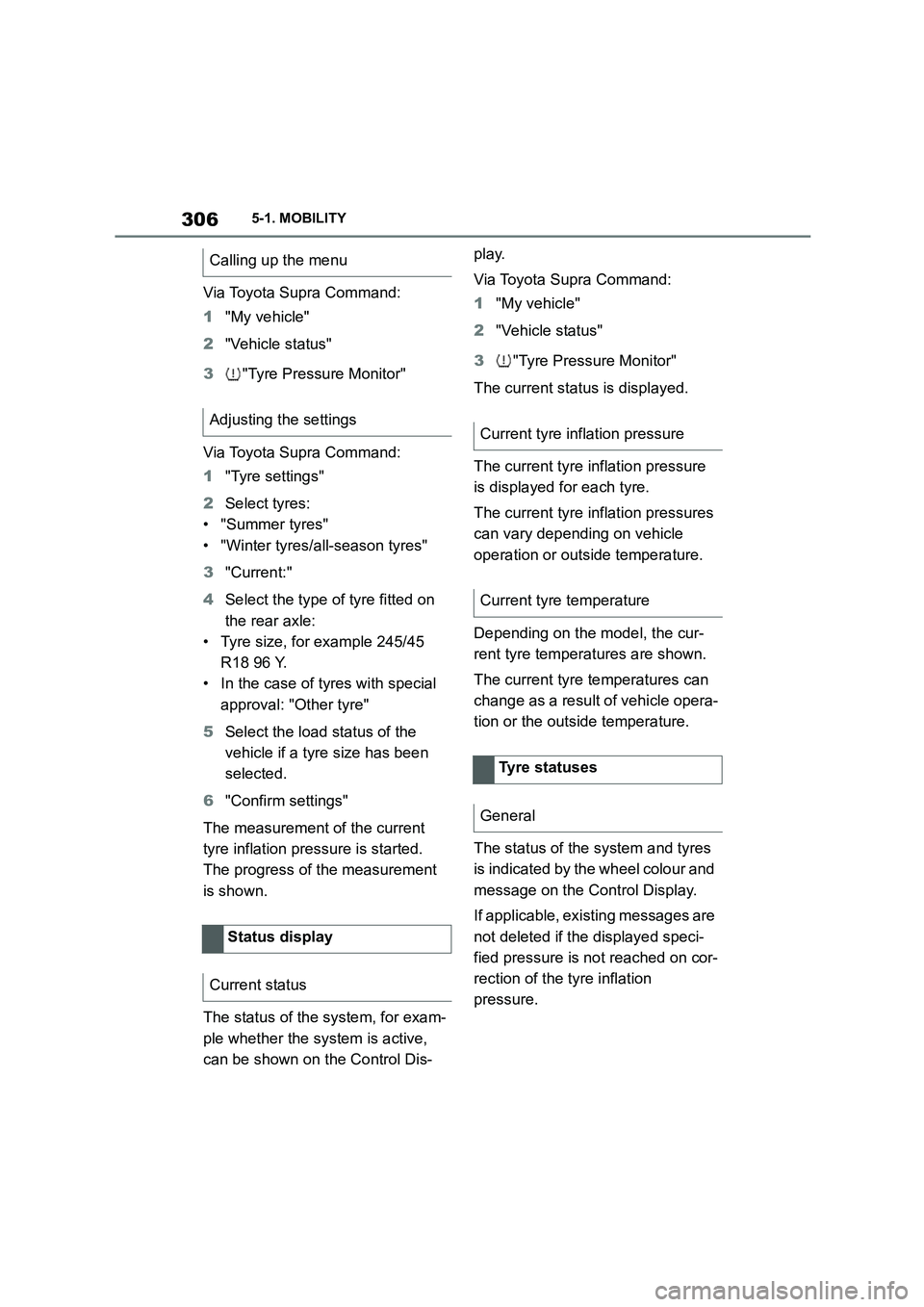
3065-1. MOBILITY
Via Toyota Supra Command:
1 "My vehicle"
2 "Vehicle status"
3 "Tyre Pressure Monitor"
Via Toyota Supra Command:
1 "Tyre settings"
2 Select tyres:
• "Summer tyres"
• "Winter tyres/all-season tyres"
3 "Current:"
4 Select the type of tyre fitted on
the rear axle:
• Tyre size, for example 245/45
R18 96 Y.
• In the case of tyres with special
approval: "Other tyre"
5 Select the load status of the
vehicle if a tyre size has been
selected.
6 "Confirm settings"
The measurement of the current
tyre inflation pressure is started.
The progress of the measurement
is shown.
The status of the system, for exam-
ple whether the system is active,
can be shown on the Control Dis-
play.
Via Toyota Supra Command:
1 "My vehicle"
2 "Vehicle status"
3 "Tyre Pressure Monitor"
The current status is displayed.
The current tyre inflation pressure
is displayed for each tyre.
The current tyre inflation pressures
can vary depending on vehicle
operation or outside temperature.
Depending on the model, the cur-
rent tyre temperatures are shown.
The current tyre temperatures can
change as a result of vehicle opera-
tion or the outside temperature.
The status of the system and tyres
is indicated by th e wheel colour and
message on the Control Display.
If applicable, existing messages are
not deleted if the displayed speci-
fied pressure is not reached on cor-
rection of the tyre inflation
pressure.
Calling up the menu
Adjusting the settings
Status display
Current status
Current tyre inflation pressure
Current tyre temperature
Tyre statuses
General